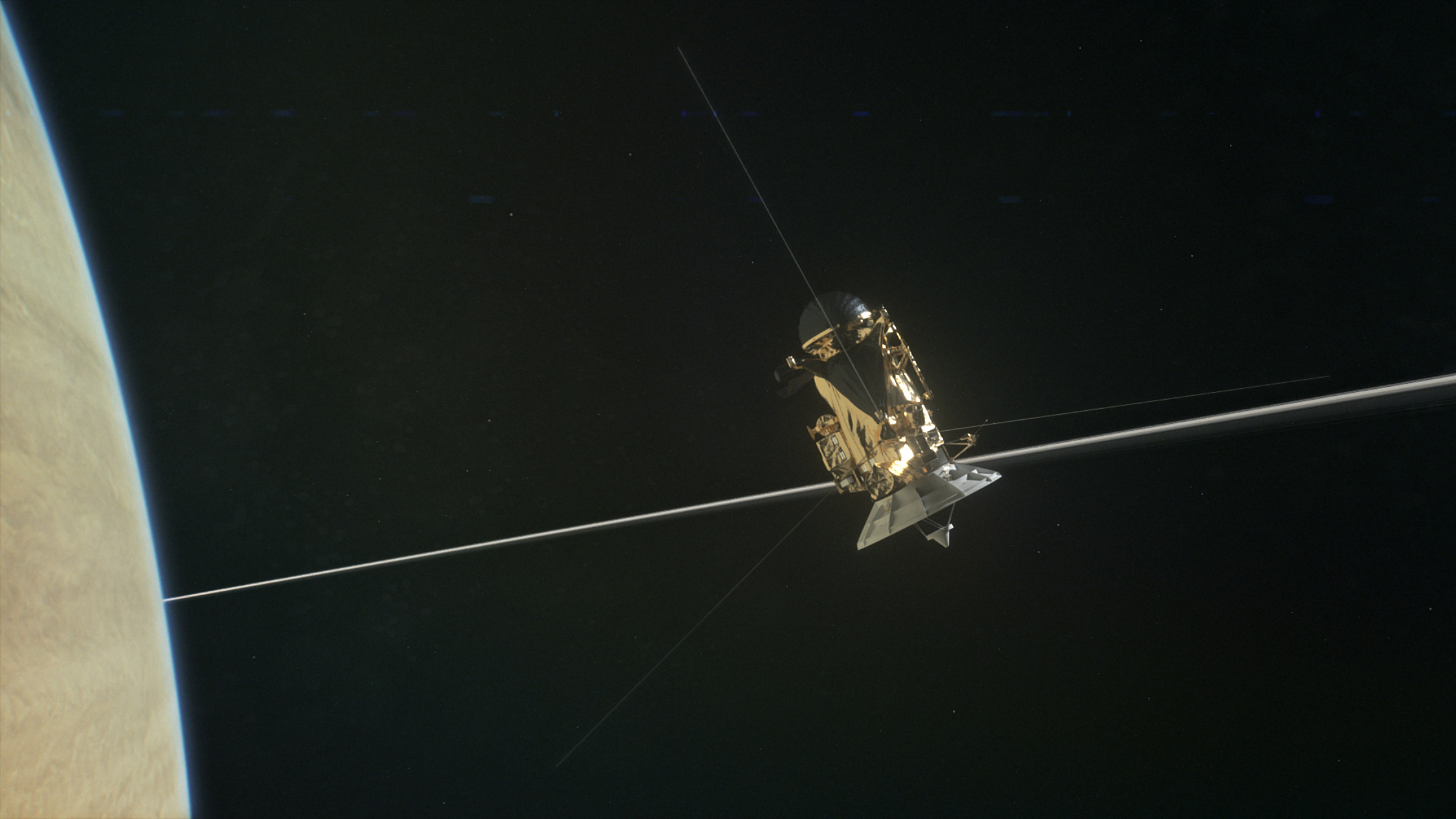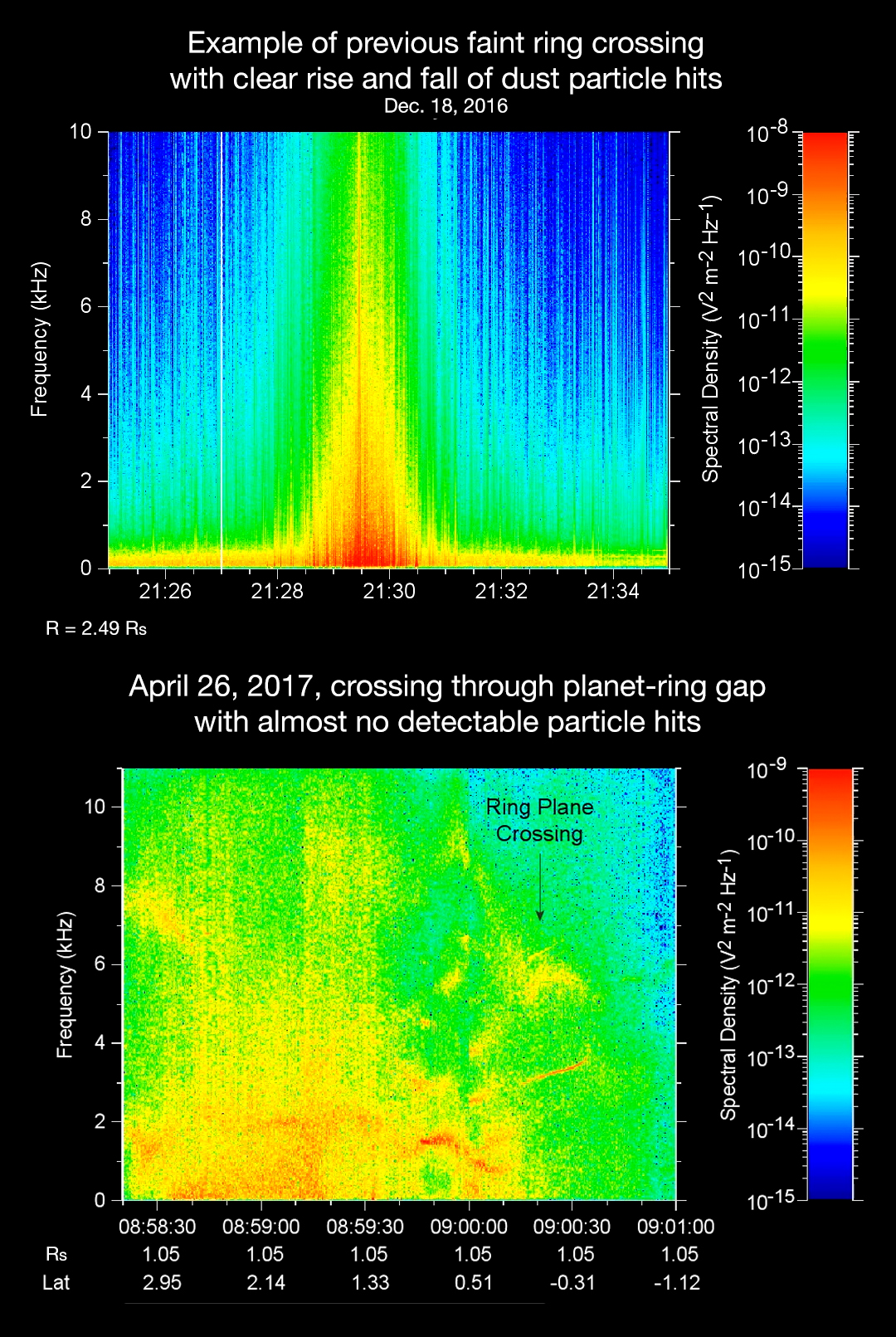Hear Saturn's 'Big Empty' from Cassini, Which Just Made 2nd Ring Dive

The space between Saturn and its rings is eerily silent: Researchers monitoring the Cassini spacecraft were surprised to encounter almost no dust and debris during the spacecraft's first dramatic dive through the gap, and you can hear the strange lack of impacts in a new NASA video.
Today (May 2), the craft made its second of 22 such dives at 3:38 p.m. EDT (1938 GMT) through the previously-unexplored 1,200-mile-wide (2,000 kilometers) region.
As Cassini made its first crossing last week, it turned to keep its large antenna in front of itself as a shield. But ultimately, that proved unnecessary: The spacecraft encountered very few particles, and none were larger than those found in smoke (about 1 micron across), NASA officials said in a statement. [Cassini's Ring-Diving Risks & Rewards at Saturn (Video)]
"The region between the rings and Saturn is 'the big empty,' apparently," Earl Maize, Cassini project manager at NASA's Jet Propulsion Laboratory in California, said in the statement. "Cassini will stay the course, while the scientists work on the mystery of why the dust level is much lower than expected."
Although unexpected, the emptiness is certainly welcome: Cassini's second dive today is through a region very close to its first dive, and so scientists are free to orient the spacecraft however they want, instead of using its antenna as a shield again. (Four of the craft's remaining dives pass through the inner fringe of Saturn's rings, NASA officials said, and so it will still need to be shielded at those times.)
To process the data from crossing the gap — which was gathered with Cassini's Radio and Plasma Wave Science instrument poking out from behind the antenna acting as a shield — the researchers converted it to audio format. As a result, pops and cracks marked dust particles hitting the instrument's antennas, NASA officials said, overlaid on the whistles and squeaks it normally detects.
When Cassini passed just outside Saturn's rings earlier in its mission, it detected hundreds of particle hits per second. But on this crossing, between the rings and the planet, it only detected a few.
Get the Space.com Newsletter
Breaking space news, the latest updates on rocket launches, skywatching events and more!
"It was a bit disorienting — we weren't hearing what we expected to hear," William Kurth, the instrument's team lead at the University of Iowa, Iowa City, said in the statement. "I've listened to our data from the first dive several times and I can probably count on my hands the number of dust particle impacts I hear."

During its second orbit and dive, Cassini rolled quickly in place to calibrate its magnetometer, and surveyed and monitored the fine structures in Saturn's rings. And it took advantage of the spacecraft's angle and investigated the composition of Saturn's moon Rhea, according to the mission page. While crossing, it came within 1,820 miles (2,930 km) of Saturn's cloud tops, where the pressure is the same as Earth's at sea level; and it came within 2,980 miles (4,780 km) of Saturn's D ring's inner edge.
Researchers are out of contact with the craft now, but it will report back tomorrow (May 3); Earth should hear back at 11:30 a.m. EDT (1530 GMT). After it completes its 22 dives through varying parts of the ring gap, the spacecraft will plunge into Saturn's atmosphere Sept. 15 in the mission's "Grand Finale."
Editor's Note: The date on this article, and the date of the second ring dive, was mistakenly marked as May 1 rather than May 2.
Email Sarah Lewin at slewin@space.com or follow her @SarahExplains. Follow us @Spacedotcom, Facebook and Google+. Original article on Space.com.
Join our Space Forums to keep talking space on the latest missions, night sky and more! And if you have a news tip, correction or comment, let us know at: community@space.com.

Sarah Lewin started writing for Space.com in June of 2015 as a Staff Writer and became Associate Editor in 2019 . Her work has been featured by Scientific American, IEEE Spectrum, Quanta Magazine, Wired, The Scientist, Science Friday and WGBH's Inside NOVA. Sarah has an MA from NYU's Science, Health and Environmental Reporting Program and an AB in mathematics from Brown University. When not writing, reading or thinking about space, Sarah enjoys musical theatre and mathematical papercraft. She is currently Assistant News Editor at Scientific American. You can follow her on Twitter @SarahExplains.









